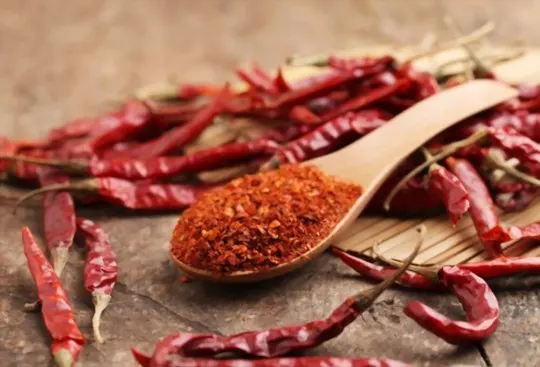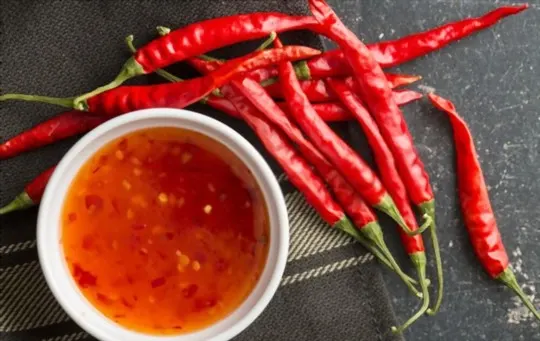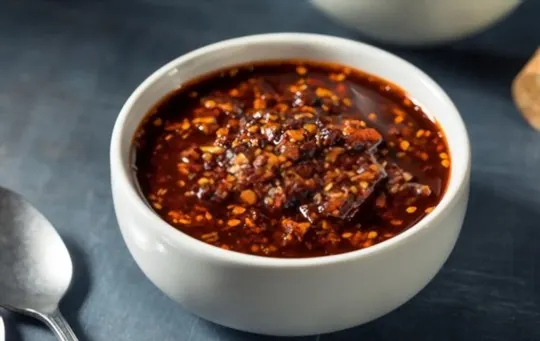Are you a fan of chili oil, but unable to get your hands on it?
Or perhaps you have some allergic reactions when using chili oil, and are looking for an alternative that can still give the same kick?
Search no further — we’ve got you covered! In this blog post, we’ll look at 7 best substitutes for chili oil as well as what to use them in so that you can easily transition over.
Whether by tracing its origins back at least 13 centuries ago or talking about how versatile it can be nowadays with different cuisines, let’s uncover all there is to know about Chili Oil Substitutes.
What is Chili Oil?

Chili oil is a type of oil that is infused with chili peppers.
It is commonly used in Asian cuisine and can be used as a cooking ingredient or as a condiment.
Chili oil has a strong, pungent flavor and a fiery red color.
The history of chili oil can be traced back to ancient China, where it was used as a medicinal remedy.
In more recent history, chili oil became popular in Asian cuisine, particularly in the Sichuan province of China.
Chili oil is now widely available in supermarkets and online stores.
Chili oil has a strong, pungent flavor with a hint of sweetness.
The heat level can vary depending on the type of chili peppers used to make the oil.
Chili oil is also often spicy, with a burning sensation on the tongue.
Chili oil can be used as a cooking ingredient or as a condiment.
It is commonly used in stir-fries, noodle dishes, and dumplings.
Chili oil can also be used to add flavor to soups and sauces.
To use chili oil as a condiment, simply drizzle it over your food.
Start with a small amount and add more to taste.
7 Best Chili Oil Substitutes
1. Cayenne Pepper

Cayenne pepper is a type of chili pepper that can be used as a substitute for chili oil.
It has a similar taste to chili oil, but it is not as spicy.
Cayenne pepper can be found in the spice aisle of most grocery stores.
To use cayenne pepper as a substitute for chili oil, add it to your recipe in the same amount that you would add chili oil.
You may need to adjust the amount of cayenne pepper depending on how spicy you want your dish to be.
Cayenne pepper is a good substitute for chili oil if you are looking for a less spicy option.
It has a similar taste and can be found in most grocery stores.
To use it as a substitute, add it to your recipe in the same amount that you would add to chili oil.
2. Sichuan Sauce

Have you ever had Sichuan sauce? If not, you’re missing out.
This sauce is typically made with a combination of chili peppers, garlic, ginger, and sometimes Sichuan peppercorns.
It’s often used as a dipping sauce or stir-fry seasoning, and it has a unique flavor that is both spicy and numbing.
If you’re looking for a chili oil substitute that will give your dish a similar taste, Sichuan sauce is a great option.
The main difference is that Sichuan sauce is typically thinner than chili oil, so it might not be ideal if you’re looking for something to use as a coating.
But if you’re looking for something to add flavor to your dish, Sichuan sauce is a great choice.
To substitute Sichuan sauce for chili oil, simply add it to your dish in the same amount that you would use chili oil.
You can also adjust the amount to suit your personal preference.
If you want your dish to be spicier, add more Sichuan sauce.
If you want it to be less spicy, add less.
3. Sweet Chili Sauce

Sweet chili sauce is a popular condiment in many Asian cuisines.
It has a sweet and spicy flavor that can enhance the taste of any dish.
If you’re out of chili oil, sweet chili sauce is a great substitute.
Sweet chili sauce is made with sugar, vinegar, and chili peppers.
It’s thick and sticky, and it can be used as a dipping sauce, marinade, or stir-fry sauce.
The sweetness of the sauce comes from the sugar, while the spiciness comes from the chili peppers.
If you want to use sweet chili sauce as a substitute for chili oil, simply add it to your dish in the same amount that you would add to chili oil.
You can also adjust the amount of sweet chili sauce to suit your taste.
If you want it to be spicier, add more chili peppers.
If you want it to be sweeter, add more sugar.
4. Homemade Chili Oil

Chili oil is a great way to add flavor and spice to your food.
But what if you don’t have any chili oil on hand? Here are seven substitutes for chili oil that will give your food the same flavor and spice.
Chili oil has a strong, spicy flavor that can be overwhelming for some.
If you’re looking for a milder substitute, try using olive oil or vegetable oil.
These oils won’t provide the same level of spice, but they will still add a flavorful kick to your dish.
How to substitute it for chili oil: When substituting olive oil or vegetable oil for chili oil, start by adding 1 tablespoon of oil to your dish.
If you want more spice, add additional tablespoons of oil until you reach the desired level of heat.
5. Heat Chilies in Oil

Chili oil is a great way to add some spice to your food.
It’s also very easy to make at home.
All you need is a pan, oil, and chilies.
First, heat the oil in the pan over medium heat.
Then, add the chilies and cook for about 5 minutes or until they are soft.
Once the chilies are cooked, remove them from the pan and let them cool.
Once the chilies are cooled, you can then start to add the other ingredients to your chili oil.
This includes things like garlic, ginger, onions and any other spices that you want to use.
Just remember to not add too much of any one ingredient so that the flavors don’t become overpowering.
And that’s it.
Now you have a delicious chili oil that you can use on all sorts of dishes.
6. Dried Peppers

Dried peppers are a great substitute for chili oil.
They have a similar taste and can be used in the same way as chili oil.
The main difference is that dried peppers will need to be rehydrated before use.
This can be done by soaking them in water for 1-2 hours.
Dried peppers can be used in any dish that calls for chili oil.
They can be added to stir-fries, soups, and marinades.
Dried peppers can also be used to make your own chili oil.
To do this, simply soak the peppers in olive oil for 1-2 hours.
Then, strain the peppers and store the oil in a sealed container.
7. Crushed Red Peppers

If you’re looking for a chili oil substitute that will give your dish a similar taste, then crushed red peppers are a good option.
These peppers can be found in the spice aisle of most grocery stores.
When substituting crushed red peppers for chili oil, use about half a teaspoon for every tablespoon of chili oil called for in the recipe.
Crushed red peppers have a slightly different taste than chili oil, but they will still give your dish the same level of heat.
If you want to adjust the level of heat in your dish, simply add more or less crushed red peppers to suit your taste.
Conclusion
In this blog post, we discussed the 7 best chili oil substitutes.
We went over the origin, history, taste, and texture of chili oil.
We also provided substitutes for chili oil in case you can’t find it at the store.
Chili oil is a great addition to any dish, so we hope this blog post has been helpful in finding a substitute for your next meal.

7 Best Chili Oil Substitutes
Ingredients
- 1. Cayenne Pepper
- 2. Sichuan Sauce
- 3. Sweet Chili Sauce
- 4. Homemade Chili Oil
- 5. Heat Chilies in Oil
- 6. Dried Peppers
- 7. Crushed Red Peppers
Instructions
- Select your favorite ingredient from the list above to use as a substitute.
- Follow the instructions and use the exact ratio of ingredients as directed.
- This will help to ensure that your dish turns out just as delicious as it would have with the original ingredient.

Carrie is a food writer and editor with more than 15 years of experience. She has worked for some of the biggest names in the food industry, including Bon Appétit, Food & Wine, and Martha Stewart Living.
As the Editor in Chief of IntroChicago.com, Carrie oversees all of the content on the site. She also manages the team of contributing writers and editors, who help to create delicious recipes, helpful tips, and informative articles that you’ll find on the site.
A native of the Chicago area, Carrie is passionate about all things food. She loves trying new restaurants and experimenting with new recipes in her kitchen. She’s also a graduate of the Culinary Institute of America, so she knows a thing or two about food!
